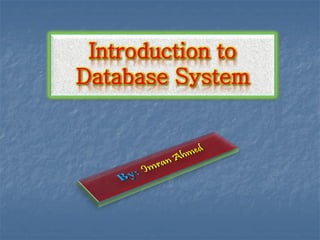
Database basics
- 3. • A collection of facts in raw form that can become information after proper organization or processing. • Data is the name given to the basic facts and entities such as name and numbers. • Data can be represented in the form of: Numbers and Words; Images, Sounds, Multimedia, etc. Data
- 4. DATA Words Sounds Numbers Images Different Forms of Data Representation
- 5. DATA (Raw Material) DATA Processing Information (Processed Data) How Will Data Process?
- 6. File The collection of related records with fields is called a file. Data in a database is saved on the computer as a data file and contains data on a particular topic, e.g., A Student File. Record The collection of related fields is called a record. A record is a collection of organized data of a particular student e.g., Ameen. Field A field is a smallest logical unit containing meaningful information in a file i.e., combination of multiple related characters. A field is part of record that holds a particular piece of data, e.g., Roll No, Name. Field, Record and File
- 7. Field Record Here are sample records from a Student data file made up of different fields: Sample Fields, Records and File Roll No Name Class Address 1 Imran 4th Sem Bhera 2 Ameen 4th Sem Chhungan Table: A Student File
- 8. Database A database is an organized, structured collection of similar information. A collection of data is referred to as database. e.g. 1. record of students stored in a student files. 2. information stored over internet. A database can be stored on paper (manual) or on a computer (electronic). A collection of data files integrated and organized into a single comprehensive file system that is arranged to minimize duplication of data, and to provide convenient access to information within that system to satisfy a wide variety of our needs.
- 9. • A program that is used for organising data on a computer is called a database package. • Data is organised in a database as files, records and fields:
- 10. To handle large amounts of data To satisfy multiple users To make data input faster To make information retrieval faster To provide greater accuracy To provide good security Why do we need a database? We need database:
- 11. Databases are used by many organisations for various purposes such as: Hospitals for preparing patients histories Govt. Departments for maintaining employees records Colleges and schools for maintaining students records Various companies for maintaining import and export records A University for maintaining information concerning students, courses and grades in a university environment Banks for preparing accounts reports What is a Database used for?
- 12. Database System DBMS + Database
- 17. Traditional File Approach Database File Approach It was an early attempt to computerize the manual filing system that we are all familiar with. A file system is a method for storing and organizing computer files and the data to make it easy to find them. The application written in C/C++ like programming languages work through this system. It is the software system that allows the user to define create and maintain a database and also provides controlled access to the data. DBMS is an intermediate layer between the programs and data. The following are the examples of database management system: • Computerized library system • Automated Teller Machines (ATM) • Flight Reservation System
- 18. Naughty Nice Just what asked for Coal Estimation Delivery List Application File ToysAddresses Toys File Based System
- 19. Database Management System (DBMS)
- 20. • This system stores permanent records in various files. • Application programs are required to extract records from, and add records to the apt files. • This system coordinates only the physical access to the data. • Data is likely to get repeated and cause redundancy. • Redundancy can lead to inconsistency of data. • Multiple user access to the information is difficult. • In this system, security of data is low. • It provides nothing to recover the data. • Examples are: Programs of C++, COBOL, etc. D-base management system • In this system, there exists a collection of interrelated files. • There is a set of application program to access and modify these files. • This system coordinates both the physical and logical access to data. • This system can control the redundancy by having a centralized database. • Having no redundancy means no inconsistency. • Multiple users can update database at the same time. • It provides security against unauthorized access. • It provides backup & recovery for data retrieval. • Examples are: Programs of Oracle, Sybase, etc.
- 21. In fo rm a tio n S y s te m F ile F ile In fo rm a tio n S y s te m In fo rm a tio n S y s te m D a ta b a s e (c o n s o lid a te d & in te g ra te d d a ta fro m file s ) F ile F ile In fo rm a tio n S y s te m In fo rm a tio n S y s te m Traditional File Processing System Database Management System